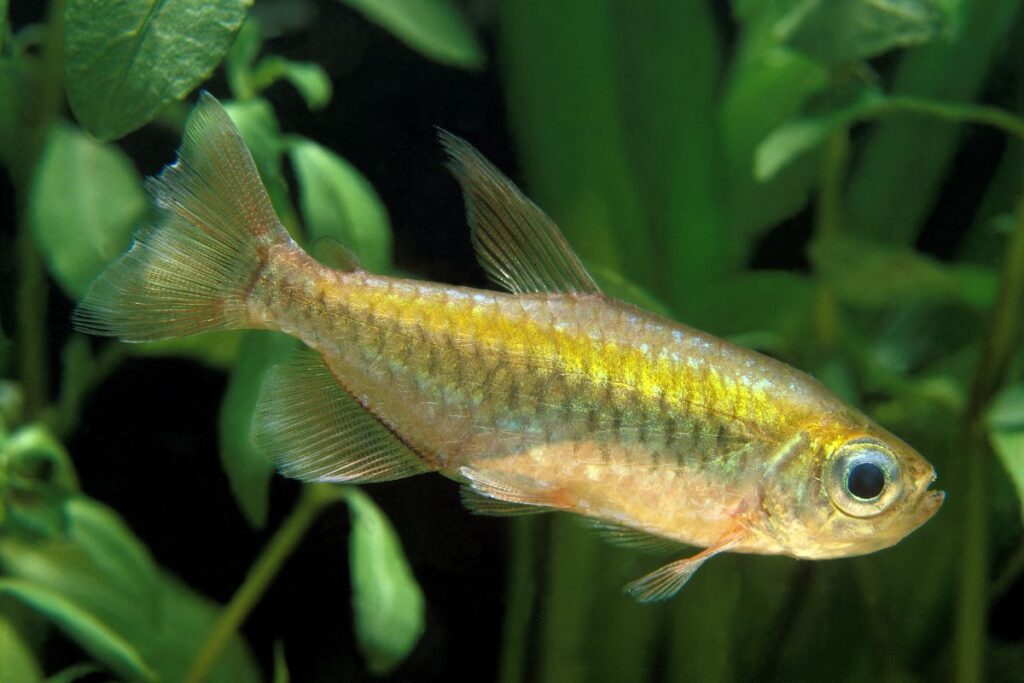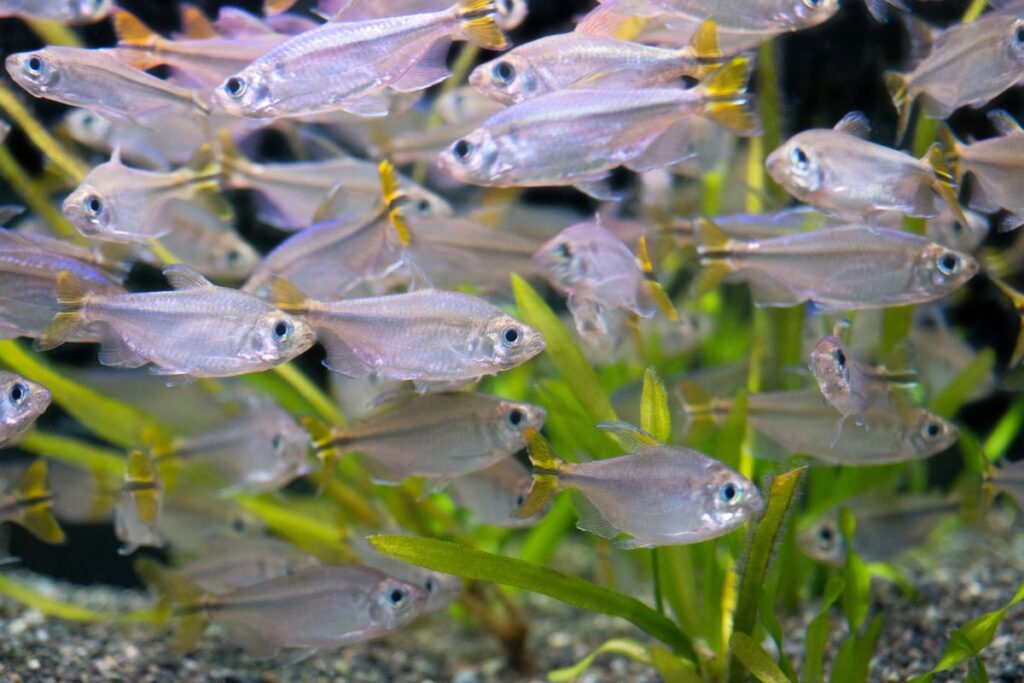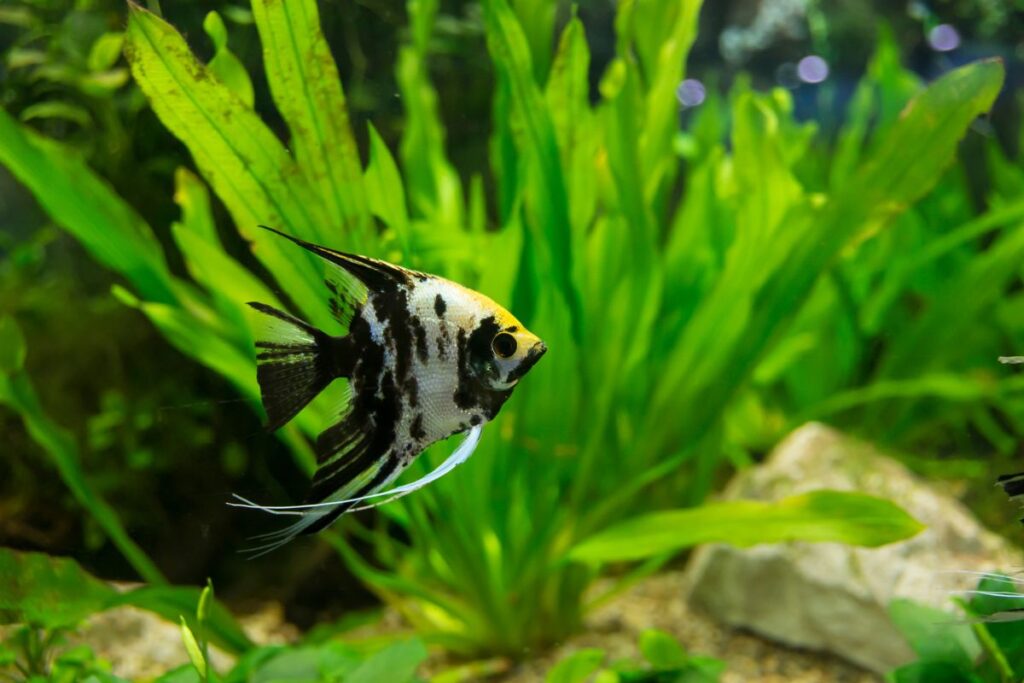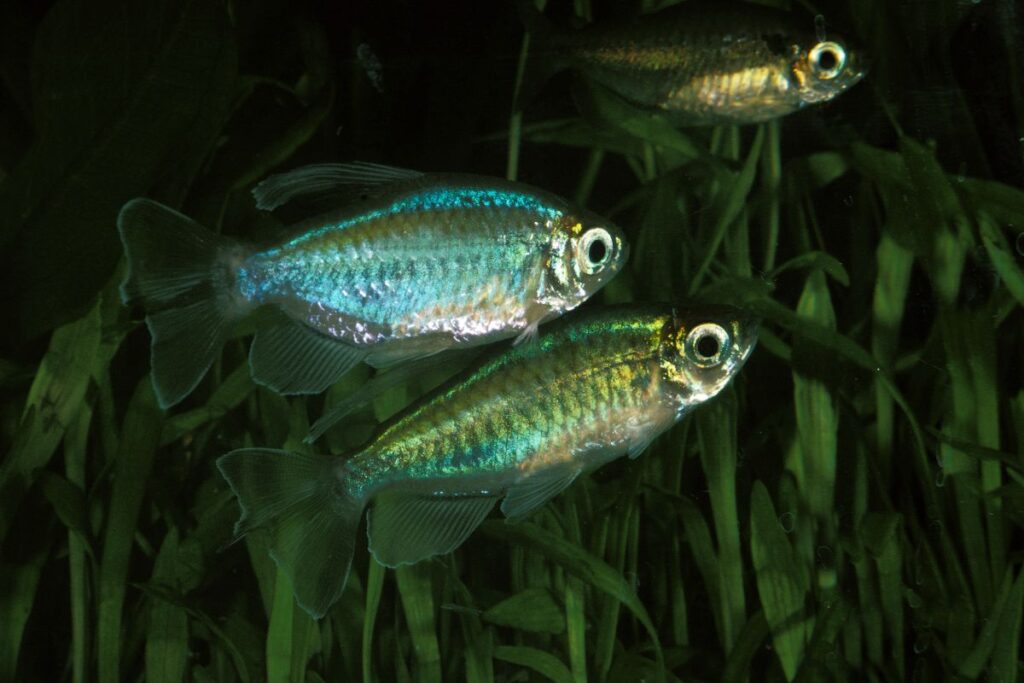If you’re looking for a stunning and peaceful fish to add to your aquarium, the Congo Tetra might be just what you need. As an avid aquarist, I have always been fascinated by the beauty and grace of this species. In this article, I will cover everything you need to know about Congo Tetra care, from tank setup and water quality to diet, common diseases, breeding, and more!
Congo tetras require a well-maintained aquarium with suitable water conditions, a varied diet, and a peaceful environment. They need a pH range of 6.0-7.5 and a temperature range between 75-82°F. The aquarium should be planted, and regular water changes should be performed to ensure their health. They are peaceful and social fish, making them an excellent choice for community tanks.
The Congo Tetra is a freshwater fish that originates from the Congo River Basin in Central Africa. These fish are known for their vibrant colors, which include shades of blue, green, and red. They are peaceful and can be kept with other non-aggressive fish. However, it’s important to provide them with the right tank setup and water conditions to ensure their health and happiness.
In this article, I will provide you with all the information you need to create the perfect environment for your Congo Tetra. I’ll cover everything from tank size and filtration to water temperature and pH levels. I’ll also discuss the ideal tank mates for these fish and provide tips on how to keep them healthy and disease-free. So, let’s dive in and explore the world of Congo Tetra care!

Table of Contents
Species Summary
As an aquarium enthusiast, I have always been fascinated by the Congo Tetra. This beautiful fish is a popular choice for many aquarium hobbyists due to its striking appearance and peaceful temperament.
In this article, I will provide a comprehensive guide on how to care for this species, including tank setup, water quality, tank mates, diet, common diseases, breeding, and more. Let’s start with a brief overview of the Congo Tetra’s species summary.
Origin
The Congo Tetra is native to the Congo River Basin in Central Africa. It can also be found in other African countries such as Cameroon, Gabon, and the Democratic Republic of Congo.
This fish prefers slow-moving rivers and streams with vegetation, making it a great addition to a well-planted aquarium.
Lifespan
The Congo Tetra has a relatively long lifespan, living up to 5 years in captivity with proper care.
However, their lifespan can be significantly shortened if they are not provided with the appropriate environment and diet.
Appearance
The Congo Tetra is a stunning fish with a metallic blue-green body and bright red fins. The males are more colorful and have longer fins than the females.
They can grow up to 3 inches in length, making them a great choice for medium-sized aquariums.
Size and Growth Rate
Congo Tetras can grow up to 3 inches in length and have a moderate growth rate. They reach their full size within a year, but their coloration and fin length continue to develop as they age.
Behavior and Temperament
Congo Tetras are peaceful and social fish that thrive in groups of 5 or more. They are active swimmers and enjoy having plenty of space to explore their environment.
They are also known for their playful behavior and will often chase each other around the tank.
Male vs Female
The males are more colorful and have longer fins than the females. They also have a more slender body shape. Females, on the other hand, have a rounder body shape and a less vibrant coloration.
Tank Setup

When it comes to setting up a tank for Congo Tetras, there are several factors to consider. In this section, I will cover the tank size, lighting, filtration & aeration, substrate, heater, decorations, and plants.
Tank Size
I recommend a minimum tank size of 40 gallons for a small group of Congo Tetras. These fish are active swimmers and need plenty of space to move around. A larger tank will also help maintain stable water parameters.
Lighting
Congo Tetras do not require any special lighting requirements. However, it is important to provide a consistent light cycle to help regulate their behavior and maintain a healthy environment.
Filtration & Aeration
A high-quality filter and proper aeration are crucial for maintaining good water quality. I recommend a canister filter with a flow rate of at least 5 times the tank volume per hour.
An air stone or powerhead can also be used to provide additional aeration.
Substrate
A fine-grained substrate like sand or gravel is ideal for Congo Tetras. Avoid using sharp or rough substrates that can damage their delicate fins.
Heater
Maintaining a consistent water temperature is important for the health of Congo Tetras. I recommend a heater that can maintain a temperature between 75-82°F.
Decorations
Congo Tetras appreciate a well-decorated tank with plenty of hiding places. Driftwood, rocks, and caves are great options. Avoid using decorations with sharp edges that can harm the fish.
Plants

Live plants not only provide hiding places for Congo Tetras but also help maintain good water quality. Java fern, Anubias, and Amazon sword are good options that can tolerate a wide range of water conditions.
Overall, setting up a tank for Congo Tetras requires careful consideration of their specific needs. By providing the right environment, you can ensure that these beautiful fish thrive in your aquarium.
Water Quality
Proper water quality is essential for the health and well-being of Congo Tetras. In this section, we will discuss the ideal water temperature, pH, hardness, and how often you should change the water in your tank.
Water Temperature
The ideal water temperature for Congo Tetras is between 76°F and 82°F. I personally keep my tank at 78°F, and my Congo Tetras seem to be thriving at this temperature.
It’s important to maintain a consistent temperature, as fluctuations can cause stress and illness in your fish.
Water pH

Congo Tetras prefer slightly acidic water with a pH between 6.0 and 7.5. I keep my pH at 6.5, which seems to work well for my fish.
It’s important to note that sudden changes in pH can be harmful to your fish, so any adjustments should be made gradually over time.
Water Hardness
Congo Tetras prefer slightly soft to moderately hard water with a hardness between 5 and 15 dGH. I keep my water hardness at around 8 dGH, and my fish seem to be doing well.
It’s important to note that excessively hard or soft water can cause stress and health issues in your fish.
Water Changes
Regular water changes are crucial for maintaining good water quality in your tank. I recommend changing 25% of the water in your tank every two weeks.
This will help remove any excess waste, nitrates, and other harmful substances that can build up over time.
Be sure to use a water conditioner to remove any chlorine or chloramines from your tap water before adding it to your tank.
By maintaining proper water quality, you can help ensure that your Congo Tetras live long, healthy lives in your aquarium.
Tank Mates
Compatible Fish Species

When it comes to choosing tank mates for Congo Tetras, it’s important to consider fish that are peaceful and won’t nip at their fins. Some compatible species include:
- Angelfish
- Discus
- Rainbowfish
- Corydoras Catfish
- Otocinclus Catfish
I have personally kept Congo Tetras with Corydoras Catfish and they got along great. In fact, the catfish helped keep the tank clean by eating leftover food and algae.
Incompatible Fish Species
Avoid keeping Congo Tetras with aggressive or territorial fish. Some incompatible species include:
- Cichlids
- Tiger Barbs
- Betta Fish
- Gouramis
I made the mistake of adding Tiger Barbs to a tank with Congo Tetras and it was a disaster. The barbs constantly nipped at the tetras’ fins and stressed them out.
How Many Congo Tetras Should be Kept Together

Congo Tetras are social fish and should be kept in groups of at least 6. In larger tanks, you can keep more. Keeping them in groups helps reduce stress and aggression.
Overall, when choosing tank mates for Congo Tetras, it’s important to choose peaceful species that won’t nip at their fins. Keeping them in groups of at least 6 will ensure they are happy and healthy.
Diet
Feeding Frequency
As an owner of Congo Tetras, I have found that they are not picky eaters and will eat most types of food.
It is recommended to feed them small amounts of food multiple times a day, rather than one large meal. I typically feed my tetras twice a day, once in the morning and once in the evening.
Types of Food
Congo Tetras are omnivores, meaning they eat both plant and animal-based foods. A varied diet is important to ensure they receive all the necessary nutrients.
I like to feed my tetras a mix of flakes, pellets, frozen foods, and live foods.
Flakes and pellets are a staple in their diet and should make up the majority of their food. I recommend choosing high-quality flakes and pellets that are specifically formulated for tropical fish.
Frozen foods, such as brine shrimp and bloodworms, are a great addition to their diet. These foods are high in protein and will help keep your tetras healthy and active.
Live foods, such as daphnia and mosquito larvae, are also a great option. Not only do they provide essential nutrients, but they also stimulate natural feeding behaviors.
It is important to avoid overfeeding your tetras, as this can lead to health problems and poor water quality. I recommend feeding them only what they can eat in a few minutes, and removing any uneaten food from the tank.
Common Diseases

Diseases
As with all fish, Congo Tetras are susceptible to certain diseases. Some of the most common diseases that affect Congo Tetras include:
- Ich
- Fin rot
- Columnaris
- Velvet
Symptoms
It is important to keep an eye out for any signs of illness in your Congo Tetras. Some common symptoms of disease include:
- White spots on the body or fins
- Torn or frayed fins
- Red or inflamed areas on the body
- Sluggish or lethargic behavior
Prevention
Preventing disease is always better than treating it. To keep your Congo Tetras healthy, make sure you provide them with a clean and well-maintained tank.
Avoid overcrowding the tank and make sure the water quality is always optimal. Quarantine any new fish before adding them to the main tank to prevent the spread of disease.
Treatment
If you do notice any signs of illness in your Congo Tetras, it is important to act quickly. There are a variety of treatments available for different diseases, but some general tips include:
- Isolate the sick fish in a separate tank
- Adjust the water temperature and pH as needed
- Administer medication as directed
- Monitor the fish closely for any signs of improvement or worsening of symptoms
Overall, keeping your Congo Tetras healthy and disease-free requires diligence and attention to detail.
By providing them with a clean and healthy environment, monitoring their behavior and appearance, and acting quickly if you notice any signs of illness, you can help ensure that your fish live long and happy lives.
Personally, I have had success in preventing disease in my Congo Tetras by regularly testing the water quality and doing partial water changes as needed.
By keeping the tank clean and well-maintained, I have been able to avoid many common diseases and keep my fish healthy and thriving.
Signs of a Healthy Congo Tetras

When it comes to keeping Congo Tetras, it’s essential to ensure that they are healthy and happy. Here are some signs that indicate your Congo Tetras are healthy:
Active and Energetic I’ve noticed that my Congo Tetras are most active during feeding time. They swim around the tank with excitement, and their colors become more vibrant. A healthy Congo Tetra is always active and energetic, swimming around the tank, exploring, and playing with other fish.
Good Appetite Congo Tetras are known for their voracious appetite, and a healthy fish will eat well. They should be eager to eat during feeding time and show no signs of lethargy or disinterest.
Clean and Clear Eyes A healthy Congo Tetra should have clear and bright eyes with no signs of cloudiness, bulging, or redness. Cloudy eyes can be a sign of bacterial or fungal infections, while bulging eyes can be a sign of dropsy.
Shiny and Vibrant Colors One of the most striking features of the Congo Tetra is its vibrant and iridescent colors. A healthy fish will have shiny, bright colors that are not faded or dull. Dull colors can be a sign of stress, poor water quality, or illness.
Good Fins and Scales A healthy Congo Tetra should have smooth and intact scales with no signs of discoloration, lesions, or sores. The fins should be erect and not clamped to the body or frayed. Clamped fins can be a sign of stress or illness, while frayed fins can be a sign of fin rot.
Normal Breathing A healthy Congo Tetra should breathe normally without gasping or panting. Rapid or labored breathing can be a sign of poor water quality, low oxygen levels, or illness. In conclusion, keeping Congo Tetras healthy is essential for their well-being and longevity. By paying attention to these signs, you can ensure that your fish are happy and thriving in their environment.
Signs of a Sick Congo Tetra
As a proud owner of Congo Tetras, I can attest to their beauty and playful nature. However, like any other fish, they are prone to illnesses.
It is important to be able to identify the signs of a sick Congo Tetra to ensure prompt treatment and prevent the spread of the disease to other fish in the tank.
One of the most common signs of a sick Congo Tetra is a loss of appetite. If your Tetra is not eating as much as usual or not eating at all, it could be an indication of an underlying health issue.
Other signs of illness to look out for include lethargy, rapid breathing, and abnormal swimming behavior.
Another sign of a sick Congo Tetra is a change in appearance. If you notice any discoloration on their skin or fins, it could be a sign of a bacterial or fungal infection.
Additionally, if your Tetra’s scales appear to be raised or they have developed any growths, it could be an indication of a parasitic infection.
It is important to note that some of these symptoms can also be caused by poor water quality or stress. Therefore, it is important to regularly check the water parameters in your tank and ensure they are within the recommended range for Congo Tetras.
If you suspect that poor water quality or stress is the cause of your Tetra’s illness, take steps to improve the conditions in your tank.
If you do notice any signs of illness in your Congo Tetra, it is important to act quickly. Isolate the sick fish in a quarantine tank and seek the advice of a veterinarian or an experienced fish keeper.
With prompt treatment and proper care, your Tetra can make a full recovery and continue to thrive in your tank.
Breeding

Breeding Congo Tetras can be a rewarding experience for aquarists who are up for the challenge. Here is what I have learned about breeding these beautiful fish.
Breeding Setup
To breed Congo Tetras, you will need a separate breeding tank. The breeding tank should be at least 20 gallons and heavily planted with fine-leaved plants such as Java Moss or Hornwort.
The water temperature should be around 78°F and the pH should be slightly acidic, around 6.5-7.0. Provide a gentle filtration and aeration system to keep the water clean and oxygenated.
Breeding Process
Congo Tetras are egg scatterers, meaning they will lay eggs all over the plants and substrate. To encourage breeding, add a breeding pair to the breeding tank and provide them with a protein-rich diet of live or frozen foods.
Once the female is ready to lay eggs, she will spawn with the male and lay hundreds of eggs on the plants. The eggs will hatch in about 24-36 hours.
Fry Care
Once the eggs have hatched, the fry will be very small and fragile. Feed them with infusoria or liquid fry food until they are large enough to eat newly hatched brine shrimp.
Keep the water clean and well-oxygenated, and avoid overfeeding. The fry will grow quickly and should be separated into their own tank once they are large enough to avoid being eaten by adult fish. Breeding Congo Tetras can be a challenging but rewarding experience.
With the right setup and care, you can successfully breed these beautiful fish and enjoy watching the fry grow and develop.
Product recommendations for Congo Tetras:
- TetraMin Plus Tropical Flakes: This high-quality fish food is specifically formulated for tropical fish like Congo Tetras, providing a balanced diet that promotes health and vitality.
- Seachem Prime This water conditioner is essential for maintaining a healthy aquatic environment for Congo Tetras. It detoxifies ammonia, nitrite, and nitrate, and also provides essential electrolytes and vitamins.
- API Freshwater Master Test Kit: This comprehensive test kit allows you to monitor the water quality in your Congo Tetra aquarium, ensuring that the pH, ammonia, nitrite, and nitrate levels are within safe ranges.
- Hikari Freeze Dried Bloodworms: Congo Tetras love brine shrimp, and these freeze-dried shrimp are a convenient and nutritious treat that can be fed as a supplement to their regular diet.
- Fluval Edge Aquarium Gravel Cleaner: This easy-to-use gravel cleaner makes maintaining your Congo Tetra aquarium a breeze. It removes debris and waste from the substrate without disturbing your fish.
- Aqueon QuietFlow LED PRO Aquarium Power Filters: This high-performance filter is designed to keep your Congo Tetra aquarium clean and healthy. It features a five-stage filtration system and LED lighting for added convenience.
- Marina Floating Thermometer with Suction Cup: This reliable thermometer ensures that the water temperature in your Congo Tetra aquarium is within the ideal range. Its floating design makes it easy to read and adjust.
- Marina Tank Scraper: This versatile tool allows you to clean the glass, remove algae, and scrape the substrate in your Congo Tetra aquarium. Its ergonomic design makes it comfortable to use.
- Zoo Med Aquatic BettaMatic Automatic Daily Betta Feeder: This automatic fish feeder is perfect for busy fish owners who want to ensure that their Congo Tetras are fed on a regular schedule. It dispenses food automatically and can be programmed to feed up to three times per day.
Conclusion
Overall, caring for Congo Tetras can be a rewarding experience for any fishkeeper. They are beautiful and active fish that can bring life to any aquarium. However, it is important to keep in mind that they require specific care in terms of tank setup, water quality, and diet.
From personal experience, I have found that providing a well-planted tank with plenty of hiding places and open swimming areas has been the key to keeping my Congo Tetras happy and healthy. I have also found that keeping up with regular water changes and monitoring water parameters has been crucial in preventing common diseases.
When it comes to tank mates, it is important to choose fish that are peaceful and compatible with the Congo Tetra’s active nature. I have had success keeping them with other tetra species, as well as peaceful bottom dwellers like Corydoras catfish.
Overall, with the right care and attention, Congo Tetras can thrive in a home aquarium. By following the guidelines outlined in this article, you can provide a healthy and happy environment for these beautiful fish.
FAQs
As a Congo Tetra enthusiast, I often get asked a lot of questions about these beautiful fish. Here are some of the most frequently asked questions:
Q: What is the ideal tank setup for Congo Tetras?
A: Congo Tetras are active swimmers and need plenty of space to move around. A minimum tank size of 50 gallons is recommended, with plenty of hiding places and plants to provide cover. The water should be slightly acidic with a pH between 6.0 and 7.5 and a temperature between 75°F and 82°F.
Q: What water quality parameters should I maintain in my Congo Tetra tank?
A: Congo Tetras are sensitive to poor water quality, so it’s essential to maintain excellent water conditions. Keep the ammonia and nitrite levels at zero, and nitrate levels below 20 ppm. Regular water changes of 25% every two weeks are recommended.
Q: What tank mates are suitable for Congo Tetras?
A: Congo Tetras are peaceful fish and can be kept with other peaceful species that can tolerate the same water conditions. Some suitable tank mates include other tetras, rasboras, and peaceful catfish like Corydoras.
Q: What should I feed my Congo Tetras?
A: Congo Tetras are omnivores and will eat a variety of foods. A balanced diet should include high-quality flakes or pellets, supplemented with live or frozen foods like brine shrimp, bloodworms, and daphnia.
Q: What are some common diseases that affect Congo Tetras?
A: Congo Tetras are susceptible to common fish diseases like Ich, Fin Rot, and Velvet. Maintaining good water quality and a healthy diet can help prevent these diseases. If you notice any signs of illness, quarantine the affected fish and treat with the appropriate medication.
Q: How can I breed Congo Tetras?
A: Breeding Congo Tetras can be challenging, but it’s possible with the right setup. Provide a separate breeding tank with plenty of plants and a pH between 6.0 and 6.5. The water temperature should be raised to 80°F, and the male and female should be conditioned with a high-protein diet. The female will lay eggs on the plants, and the male will fertilize them. Remove the parents after spawning to prevent them from eating the eggs.
Overall, Congo Tetras are beautiful and fascinating fish that can make a great addition to any aquarium. With proper care and attention, they can thrive and provide years of enjoyment.
Reference: Wikipedia.
